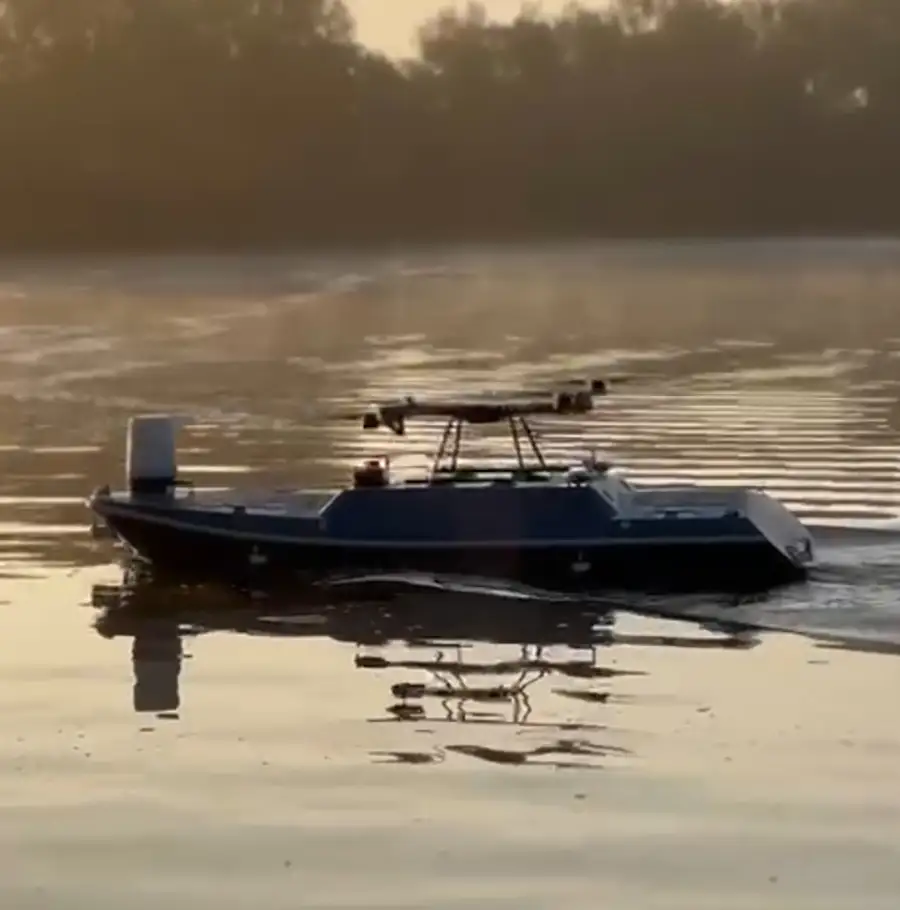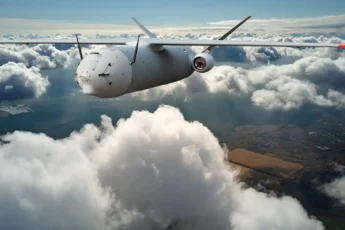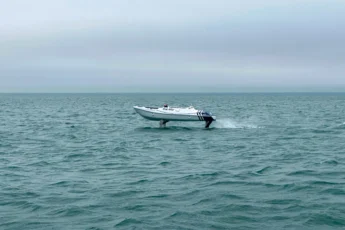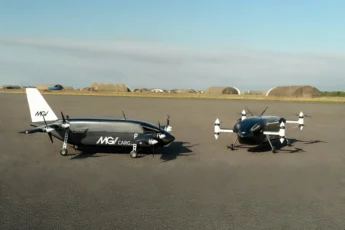As autonomous technologies mature, they are reshaping how maritime forces deliver supplies, gather intelligence, and project power from ship to shore. From reconnaissance and mine countermeasures to precision strike and resupply, maritime drone systems are redefining how naval forces operate across oceans, littorals, and inland waterways.
One of the most game-changing developments is the emergence of multi-role maritime drones—platforms that do more than just collect data or deliver a single payload. Today’s leading systems can transport cargo, deploy additional aerial or underwater drones, and operate independently for extended periods in denied or contested environments.
Among these, SeaGlide—MGI Defence’s autonomous maritime delivery system—is a platform that reflects the future of scalable, modular, multi-mission autonomy at sea.
What Are Maritime Drone Systems?
Maritime drone systems, or Unmanned Surface Vehicles (USVs) and Unmanned Underwater Vehicles (UUVs), are autonomous or remotely operated platforms designed to perform naval missions without onboard crew.
They vary widely in:
- Size (from man-portable to vessel-sized)
- Mission type (surveillance, logistics, EW, strike)
- Autonomy level (remotely piloted, semi-autonomous, or fully autonomous)
- Operational domain (surface, subsurface, amphibious)
While unmanned systems have long supported naval ISR, new generations of AI-enabled maritime drones are capable of far more complex, autonomous behaviours—including coordinated delivery missions, swarm deployments, and autonomous launch of secondary platforms.
Ukraine’s Maritime Drone Program: A Turning Point
The war in Ukraine has underscored the disruptive power of low-cost maritime drone systems. In particular, Ukraine’s innovative use of explosive-laden USVs has:
- Challenged the dominance of large naval fleets
- Demonstrated that speedboats and inflatable hulls can defeat conventional warships
- Forced adversaries to divert air and naval assets to counter small, unmanned threats
But beyond the headlines about explosive attacks, the real lesson is the asymmetric impact of scalable, affordable, and networked maritime drones.
These systems:
- Reduce risk to personnel
- Bypass traditional naval defences
- Enable precision in shallow or cluttered waters
- Allow distributed operations across vast coastal zones
As larger navies seek to integrate similar capabilities, the emphasis is now on systems that can operate independently and support other autonomous assets—not just execute one-off attacks.
Autonomous Ship-to-Shore Delivery: Bridging the Final Mile
One of the most pressing challenges in maritime logistics is the “final mile”—delivering supplies from ship to shore, particularly in unprepared or denied landing zones. Amphibious operations, humanitarian missions, and special forces deployments all require covert, autonomous logistics that don’t rely on ports, beaches, or exposed rotorcraft.
Autonomous ship-to-shore delivery systems offer:
- Rapid resupply to forward positions along the coast
- Reduced signature, minimising radar or thermal detection
- Mission flexibility, adapting to dynamic shore environments
- No need for human operators, reducing risk and logistical burden
This is where systems like SeaGlide stand out—not only for their ship-to-shore capability, but also for their modular payload bays and ability to launch airborne drones, such as cargo UAVs or loitering munitions, once close to shore.

SeaGlide: A Maritime Launch Platform for Autonomy at Scale
Developed by MGI Defence, SeaGlide is an autonomous surface drone optimised for coastal delivery, multi-drone deployment, and stealthy insertion missions.
It is designed to:
- Carry heavy payloads over long distances
- Navigate autonomously through GPS-denied or EW-contested environments
- Launch other autonomous systems—such as cargo drones or loitering effectors—from sea to shore
- Operate in swarm formations for redundancy and mission shaping
- Launch from ship, shore, or submarine deck
SeaGlide allows for a two-stage autonomous mission:
- Maritime transit using a low-profile, radar-deflecting hull
- Airborne deployment, using a launch mechanism for UAVs like the R10 or Mosquito
This approach dramatically extends the range and flexibility of logistics or strike missions, enabling access to areas that would traditionally be unreachable without large-scale naval support.
Force Multiplication Through Modular Autonomy
Modern maritime drone systems aren’t just tools—they’re force multipliers.
With the ability to launch, recover, or coordinate with other unmanned systems, maritime drones create a web of capability across multiple domains:
- Aerial: Launching drones like loitering munitions or surveillance UAVs
- Surface: Operating in groups or controlling other USVs
- Subsurface: Delivering UUVs for mine detection, sabotage, or ISR
This modular, multi-domain capability enables small naval units—or even coastguard-style patrol forces—to perform complex missions previously reserved for destroyers or carrier groups.
The result is a levelling of the playing field: nations no longer need billion-pound vessels to project force or secure maritime supply routes.
Applications Across Defence and Security
The rise of autonomous maritime systems opens up new mission profiles across defence, disaster response, and border control. Key applications include:
Tactical Logistics
- Resupply for special forces in coastal or island environments
- Emergency cargo delivery to disaster zones or siege conditions
Infrastructure Protection
- Autonomous patrols of undersea cables, pipelines, and ports
- Drone-on-drone defence in littoral zones
Offensive Operations
- Launch of loitering munitions or anti-ship one-way effectors
- Saturation tactics in grey zone conflict
ISR and Surveillance
- Persistent presence without risking manned platforms
- Real-time intelligence collection with reduced footprint
As these capabilities mature, interoperability between platforms will become critical—driving further innovation in open architecture, autonomous coordination, and low-signature materials.
The Strategic Value of Autonomy at Sea
Whether in open ocean or cluttered archipelagos, the naval battlespace is becoming more autonomous, more distributed, and more contested. Large warships still play a role, but they increasingly rely on unmanned systems to extend their reach, protect their assets, and deliver effects discreetly.
Maritime drone systems like SeaGlide address this shift head-on. They are:
- Scalable: Easy to mass-produce and deploy in large numbers
- Adaptable: Modular payloads for different missions and environments
- Survivable: Designed for stealth, evasion, and low-value targeting
- Expendable: Affordable enough to use in high-risk environments
As navies around the world modernise in the face of budgetary, logistical, and geopolitical constraints, autonomous platforms offer both capability and economy.
Conclusion: Autonomy Is Now a Maritime Imperative
The days of unmanned surface vehicles being niche or experimental are long gone. From the coasts of Ukraine to contested waters in the Indo-Pacific, maritime drones are proving their worth—both as strike platforms and logistics enablers.
By integrating with air and undersea systems, and by delivering supplies or effects without putting personnel at risk, platforms like SeaGlide represent a new chapter in naval autonomy.
Whether operating solo or as part of a wider autonomous task force, maritime drones are here to stay—and their capabilities are growing exponentially.
Explore SeaGlide
To learn more about MGI Defence’s autonomous maritime logistics and deployment platform, visit:






